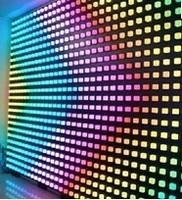Hi,
I have already tried connecting teensy to 3000 ws2812b leds and it looks magnificent.
Now since those are too bright i want to try the same with ws2801. All I want to know is how can I connect all those leds to a single teensy as i did before.
I know that ws2801 needs two signals as data and clock i.e. din and sck.
How can I get both from only din?
Few days back I saw a module that converts din signal into two separate din and sck. But now I can't find the same link.
Is there anything similar available?
Please Help.
I have already tried connecting teensy to 3000 ws2812b leds and it looks magnificent.
Now since those are too bright i want to try the same with ws2801. All I want to know is how can I connect all those leds to a single teensy as i did before.
I know that ws2801 needs two signals as data and clock i.e. din and sck.
How can I get both from only din?
Few days back I saw a module that converts din signal into two separate din and sck. But now I can't find the same link.
Is there anything similar available?
Please Help.


